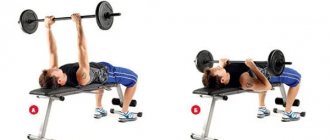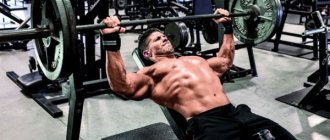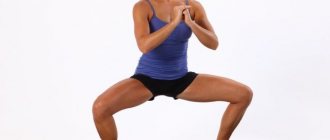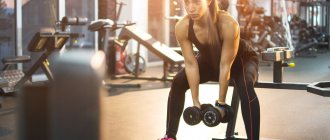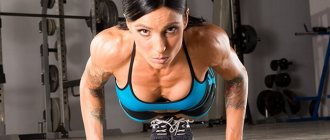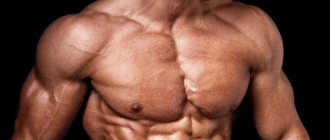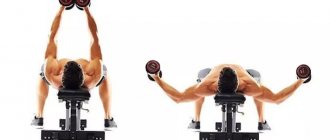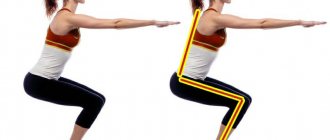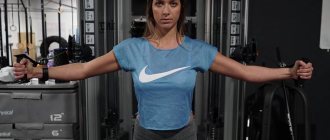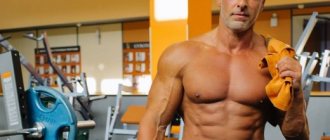July 26, 2022 Admin Home page » Tips and tricks
TOP 7 exercises for good drawing of the inside of the chest. The technique and detailed video for correct implementation are described. Tips for breast pumping.
Most athletes who love iron and simply lead a healthy lifestyle have clearly visible edges of the pectoral muscles, the so-called outer part of the chest. However, the central part, and especially the inner part, is usually underdeveloped, which, when looking at the figure from the outside, will cause a feeling of not being completely perfect. To eliminate this muscle imbalance, you need to know how to pump up the inner pectoral muscles and what are the most effective exercises in this regard.
Why does the inner part of the breast lag behind?
First of all, this potential is genetically based; from birth, some have a well-developed back, others have powerful legs, others have voluminous arms, but at the same time the chest does not lend itself to the necessary development.
The second reason is an incorrectly designed training program. For example, many people like to perform barbell bench presses and sometimes dips, while forgetting about the incline bench, fly-ups, crossover work, and so on. Which ultimately develops a certain area of the pectoral muscles, which over time becomes overdeveloped and differs in volume from other muscle areas.
Find out the full list of chest exercises here.
Chest workout program
Raising arms to the sides on the lower block
- 3-4 sets of 8-12 reps
- Body part: Shoulders Equipment: Block
Smith Machine Bench Press
- 3-4 sets of 8-12 reps
- Body part: Chest Equipment: Exercise machine
Pullover with barbell
- 3-4 sets of 8-12 reps
- Body part: Lat Equipment: Barbell
Bench press on an incline bench
- 3-4 sets of 8-12 reps
- Body part: Chest Equipment: Barbell
Raises with dumbbells lying on an incline bench
- 3-4 sets of 8-12 reps
- Body part: Chest Equipment: Dumbbells
Add to Calendar * Add to My Workouts * Print Workout
* — The service is in beta testing
Did you feel a rush of blood to your pectoral muscles? Agree, Arnold Schwarzenegger was right when he wrote that the most wonderful feeling in the world is when you feel a rush of blood to your muscles. In addition, this state guarantees you three very important things:
- This means that you are training your pectoral muscles correctly without putting stress on your joints.
- Blood in the hands stretches the fascia, the dense fibers surrounding the muscles. The more you stretch the fascia, the more room there is for muscle growth.
- Blood delivers nutrients to the muscles, which are necessary for repair and hypertrophy.
You may be hearing about some of these exercises for the first time, but these exercises are simple, effective and at the same time minimally dangerous, which cannot be said about the bench press. Try doing a full workout of these movements, or gradually incorporating them into your program.
Sports nutrition will help speed up the process of gaining muscle mass - protein, creatine, gainer, arginine, BCAA, amino acids. These supplements are specially designed for athletes and fitness-active people of different fitness levels. Such drugs are completely safe, and their effectiveness has already been proven.
Recommendations for effective pumping of the inner chest area
There are several basic principles that help achieve more effective results:
♦ internal training is performed twice a week, between training there should be 2-3 days of rest;
♦ do not exclude the classic bench press from your training, this is a basic exercise for developing the entire mass of the pectoral muscles and will only be an assistant for building up the inner part of the pectoral muscles;
♦ it is necessary to increase the working weight every 2-3 workouts, which will allow more and more muscle fibers to be involved in the work and will not allow the muscles to get used to a monotonous load;
♦ during 1 exercise it is necessary to perform 1-2 warm-up approaches and 3-4 working approaches with the main weight. The number of repetitions should be 8-12 for building mass, and 12-15 repetitions for drawing and performing isolation exercises.
♦ chest training always involves the shoulder joints, so in order to avoid injury before chest training, it is always necessary not only to warm up in the chest area, but also the shoulder girdle.
Results
If you train at home, you can still pump up your chest and increase muscle size. If you can't do the bench press, don't worry—there are plenty of other exercises that will work better for you. Think about it, there were TEN different push-ups listed here!
Usually people start worrying about the movements they can't do and completely forget about the ones they can do. Use these exercises and workout plan to build chest muscles you can be proud of at home.
Top 7 exercises for the center and inner chest area
It is almost impossible to train the inner and central sections of the chest separately, so the right decision would be to choose exercises that involve the central section of the chest as much as possible.
Chest training puts stress on your shoulders, so warming them up is a must!
Close grip bench press
The exercise is performed both with a barbell and in a Smith machine.
- you need to lie on a horizontal bench, take the bar in such a way that there is a distance of 20-30 cm between your hands;
- Remove the barbell as you exhale and lower it as you inhale; then press it hard and lower it as you inhale;
- keep your elbows as close to the body as possible and lift the barbell not by pushing from the chest, but solely by the strength of the chest and triceps;
- In this case, having a partner as a backup wouldn’t hurt.
Mixing in crossover on lower blocks
Among the best for training the inner chest
- take the lower blocks of the crossover by stepping one foot slightly forward about 0.5 meters;
- slightly bending your arms, bring them from bottom to top diagonally, almost until your hands touch each other, but at the same time maintaining a 5 cm distance, otherwise when the lower handles touch, part of the load from your chest will be lost;
- the elbows remain slightly bent from the beginning to the end of the exercise;
- then lower the handles to the starting position, but do not allow the weight to rest completely on the plates; at the lowest point, the tension of the pecs should be felt, which will allow them to stretch well before the subsequent powerful reduction;
- Bring your arms together without jerking, only using your chest, otherwise your shoulders can be easily injured.
Narrow (diamond) push-ups
Excellent exercise at home or on holiday
- Having assumed a push-up position, leave a distance of 5-10 cm between your hands;
- as you inhale, lower yourself almost to the floor, leaving a distance of about 10 cm, and as you exhale, rise up;
- do not let your head rise up, sinking your hips, or, on the contrary, lift your butt up, all this will make the exercise easier, but also relieve the load on the chest and triceps. The body from the heels to the top should be taut like a string.
Svend press
This exercise is often performed by girls, but it will not be superfluous for guys either.
- in a standing or sitting position, hold 2 pancakes between your palms and with outstretched arms at chest level, bring the pancakes closer and further away from your chest;
- start training with 2.5 kg. and gradually increase it from workout to workout;
- The pectoral muscles must always be tense during the exercise; to do this, you must press the pancakes together with all your might;
- do not forget to breathe, when moving the pancakes away - exhale, and bringing them to the chest - inhale.
Pullover with dumbbells
- you need to lie on a gymnastic bench, usually it is placed across the back so that the hips hang down and the emphasis is only on the shoulder blades, this is more convenient, you will understand during the exercise;
- lifting the dumbbell above your chest, you need to hold it between your palms, bulge your chest, slightly bend your elbows and lower the dumbbell on slightly bent arms behind your head;
- lower as you exhale, raise as you inhale to the center of your chest, holding the dumbbell at the top.
Butterfly (butterfly)
- first you need to adjust the seat so that your elbows are at chest level when grabbing blocks;
- do not forget the lever at the bottom, which must be pressed with your foot, which will make it easier to install the levers in your hands;
- press your back tightly against the backrest;
- bring your arms together as you exhale, leaving 5 cm between the blocks; arch is done while inhaling.
Wiring on TRX loops
Not every gym has them in stock, but if you see them, don’t be lazy to try them. Due to the lack of rigid stability, the core muscles and many stabilizing muscles of the torso are involved in the work, which will give an effect for training the whole body.
- holding the loops, the body must be tilted forward;
- in the starting position, the arms are straightened in front of you;
- while inhaling, perform the extension to the side, and while inhaling, bring it in front of the chest. During the exercise, you should keep your arms slightly bent at the elbows so that the load remains inside the chest and there is no strong pressure on the elbow joints.
Exercises without special equipment
Set of three push-ups
This complex will help pump up all parts of the pectoral muscles one by one. Lifehacker discussed each of these exercises in detail in this article.
- Do push-ups with your feet elevated. This exercise puts stress on the upper pectoral muscles.
- Immediately after this, do push-ups on the floor with your arms wide. The arms are positioned at the same level as the shoulders. This type of push-up will pump up the middle part of the pectoral muscles.
- The last push-up in the complex is with your hands on a hill. It provides stress on the lower part of the pectoral muscles.
If you want to complicate the complex, put a backpack with dumbbells or other weights on your back. The main thing is that the backpack fits tightly to your back and does not move during push-ups. A tourist one, which is fixed on the body with the help of additional fasteners, is well suited.
Push-ups with body weight on one arm
This exercise is much more difficult than classic push-ups; it provides a serious load on the pectoral muscles, but requires training and arm strength.
- Stand in a lying position, shift your body weight towards your right hand.
- Lower yourself into a push-up and at the bottom point transfer your body weight to your left hand.
- Push yourself up, leaning primarily on your left hand, and then transfer your body weight back to your right hand and repeat the exercise.
- Repeat the approach with the other hand. In the second approach, lower yourself with emphasis on your left hand, and rise with emphasis on your right.
Raising arms on the floor
For this exercise, you will need a fairly slippery floor - tile or smooth linoleum - and two towels or pieces of cloth.
- Stand in a lying position, place your hands on towels.
- Carefully spread your arms out to the sides as wide as possible so that you can then stand up.
- Collect your hands, taking the starting position.
Perform the exercise as consciously and carefully as possible: spread your arms only to the width from which you can rise.
Lateral push-ups
- Lie on the floor on your right side, place your right hand on your left shoulder, and place your left hand on the floor in front of you.
- Push yourself upward with your left hand so that your body rises from the floor. The pelvis remains on the floor.
- Lower yourself to the floor again and repeat the exercise.
- Repeat on the other side.
Dips
For this exercise you will need parallel bars. These complexes are sold with a horizontal bar and parallel bars for home use, on which you can perform many exercises. If you're not in the mood to spend money, you can find bars at any sports field or school stadium.
- Jump onto the bars and keep your body weight on straight arms. Lower your shoulders, cross and slightly bend your legs.
- Lower yourself down, bending your elbows, until your shoulders are parallel to the floor or slightly lower. Try to keep your elbows close to your body, pull your shoulders back and down, and squeeze your shoulder blades.
- To work the pectoral muscles, and not the triceps, during push-ups, tilt your chest slightly forward - at an angle of about 30 degrees.
- Push yourself up, tensing your abs, and repeat the exercise.
Isometric exercises to help
Isometric contraction involves basic exercises where you apply force against a stationary object (a wall, table, or other body part).
Isometric exercises have long been in the spotlight, and the method gained popularity thanks to Charles Atlas, who introduced the world to his work “Dynamic Tension”.
The main advantage of isometric contraction is that you don't need any equipment to achieve great results. This technique allows you to push your muscles to failure at the end of a workout, and it can also be performed throughout the day to maintain the tone of the pectoral muscles. An example of an isometric exercise:
Palm Press: Squeeze your palms together as tightly as possible while keeping your elbows raised. For maximum effect, hold the resistance for 10-30 seconds.
Why should I train my pectoral muscles regularly?
Because you're a guy. A wide chest is synonymous with masculinity. Superman, Hulk, Tarzan - they all look great thanks to their wide chests. In addition to appearance, a well-toned chest helps you better take a fall and then stand up easily. Since the pectoral muscles are rarely used in everyday life, it is important to regularly include chest training in your training plan.
Broad chest is synonymous with masculinity
What should you pay attention to (as a beginner) when training your pectoral muscles?
Rule #1: Don't overdo it. Those who only focus on breast size will soon become a gorilla. Be careful not to neglect your upper back muscles, otherwise you will develop a hump with your shoulders hanging forward. By the way, most pectoral muscle injuries occur in men aged 20 to 30 years. According to researchers from Boston University, young guys are now more likely to exaggerate their weight choices. Men especially like to overestimate the classic bench press. To ensure you can train even harder tomorrow, you can reduce the weight or help each other with the final reps.
But there are no false ambitions - those who exert themselves reap athletic results instead of ridicule
